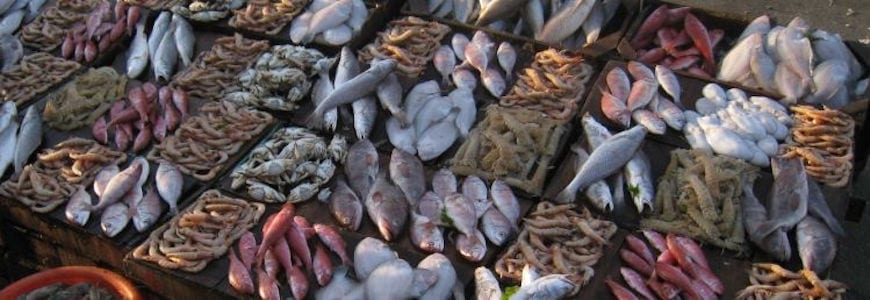By Rob Mitchum // August 22, 2017
Most studies of how climate change will impact global food production focus on crops, where the effects of higher temperatures and drier weather are well characterized. But the world’s meals increasingly include seafood, and the production from fisheries and aquaculture has tripled in the last 50 years. The climate sensitivity of this industry may be just as large as that of crop agriculture, and the interconnectedness of these sectors in many countries raises worries about biodiversity and resilience.
In a new paper for Nature Ecology & Evolution, an international team of researchers show that 87 coastal countries could face decreases in bothmarine and land-based food production as the climate changes. Among the authors of the study is Joshua Elliott, Computation Institute fellow and research scientist at the Center for Robust Decision-Making on Climate and Energy Policy (RDCEP).
Lead author Associate Professor Julia Blanchard of the Institute for Marine & Antarctic Studies (IMAS) said the study highlights the significant challenges facing many countries as they strive to reduce hunger, poverty and biodiversity threats under the growing human population and climate change.
“Global food security and environmental policies often separate sectors on land and sea, despite the important role of seafood and fisheries in the global food system,” Blanchard said. “Our method of combining information on food production, biodiversity threat, human development, and future climate change projections for fisheries and agriculture is a first step towards identifying vulnerable countries and the potential trade-offs they face under future scenarios.”
Professor Beth Fulton from the Commonwealth Scientific and Industrial Research Organisation (CSIRO) in Australia said the research showed that while a few countries have increased food production by 2050, 87 of the world’s 119 coastal countries face declines in both agriculture and fisheries production by 2050.
“Although there are uncertainties associated with these projections, our assessment provides information for the countries facing this potential double-jeopardy to develop plans needed to adapt, for example by looking to trade partners or finding national solutions to boost food production,” Professor Fulton said. “Developed nations are expected to have the capacity to adapt. However, less-developed nations face some of the greatest declines while also currently have less capacity to adapt and face other societal and environmental threats.”
Professor Reg Watson from IMAS said these new challenges are emerging at a time when further improvements to fisheries management are still being pursued to reduce overfishing and biodiversity loss, as well as to alleviate hunger and poverty in many countries.
“We expect that wild seafood will make a vital but decreasing relative contribution to the global food supply in the next 30 years due to the strengthening of more controlled production systems such as aquaculture and the development of new methods of food and feed production.”
The study highlights the importance of accounting for critical links and trade-offs across marine and terrestrial food production and ecosystems to achieve global sustainable development goals (e.g. United Nations Sustainable Development Goals). Projections about the effect of climate change on agriculture and aquaculture used simulation output from the Inter-Sectoral Model Inter-Comparison Project, where Elliott is agricultural sector coordinator.

